The Neophyte's Custom Liquid Cooling Guide: How To, Why To, What To Expect
by Dustin Sklavos on September 30, 2013 12:01 AM ESTThe last part of our objective testing is in measuring noise levels, thermals, and power consumption. All of these theoretically go up due to increased voltages on the CPU and graphics cards as well as just the overhead in running the liquid cooling system. Remember that we've added a water pump and essentially increased the number of case fans from three to six.
As I mentioned in my initial review of the Corsair Carbide Air 540, noise levels for the case itself aren't particularly stellar but they're not horrible either. Where we do benefit from the Gigabyte G1.Sniper 5 motherboard is its spacing between the two graphics cards; the board is designed to support four cards, so there's plenty of room for both cards to breathe.
First, we'll take a look at thermals.
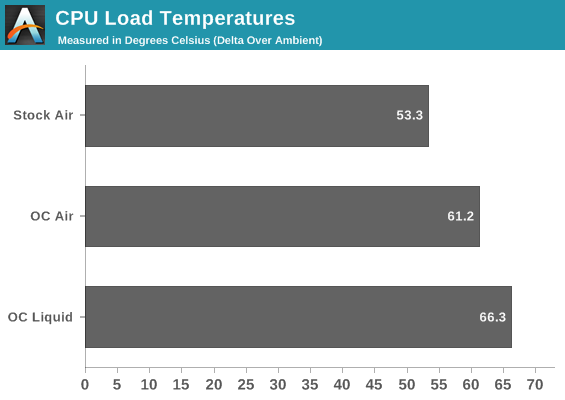
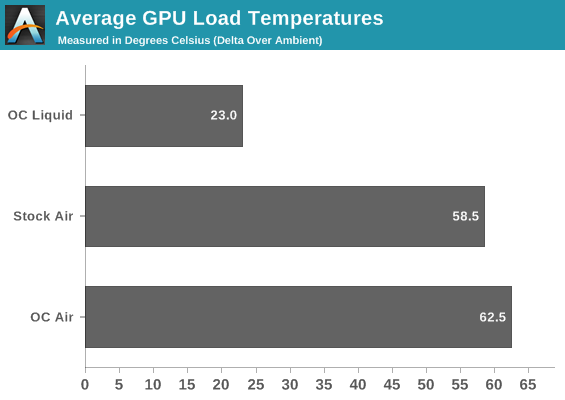
What should be striking is the increase in temperatures on the CPU going from air to water, but remember that we also were able to add a substantial amount of voltage in the process to hit 4.4GHz. Doubly striking is the way the load temperatures on the 780s are more than halved.
Despite the GPUs drawing substantially more power (and thus generating more heat) than the CPU, they also have much higher surface area and less overall heat density. We also benefit from direct contact between the heatsink and the GPU die, while Intel uses poor quality glue and thermal paste to bond the 4770K's die to the heatspreader. Ultimately it becomes too difficult to transfer heat off of the 4770K fast enough.
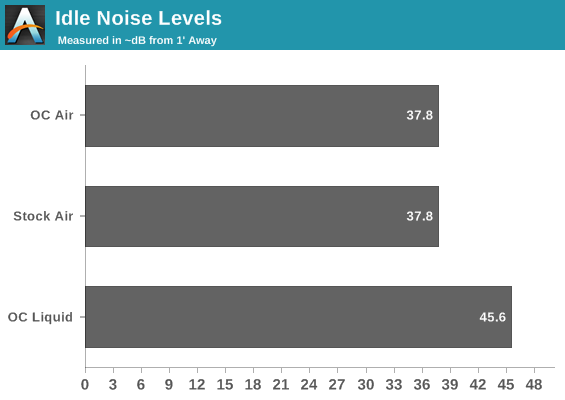
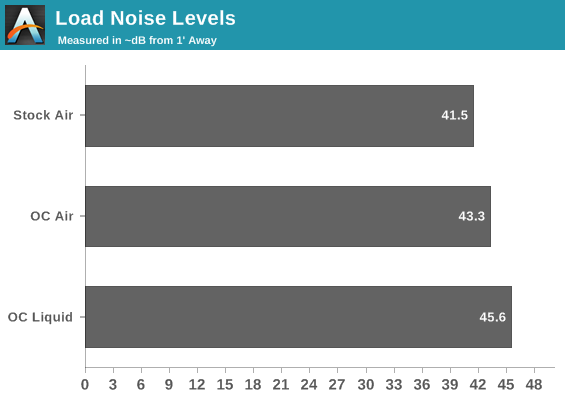
The reality is that none of these noise results are particularly uplifting, but there is a silver lining. If you shift down to 4.3GHz and lose all that voltage that was needed to hit 4.4GHz, you can also reduce the speeds on all of the fans and at least get your noise levels down substantially. Idle noise drops to about 31dB, with load noise closer to 35db or 36db. It's a lot more tolerable.
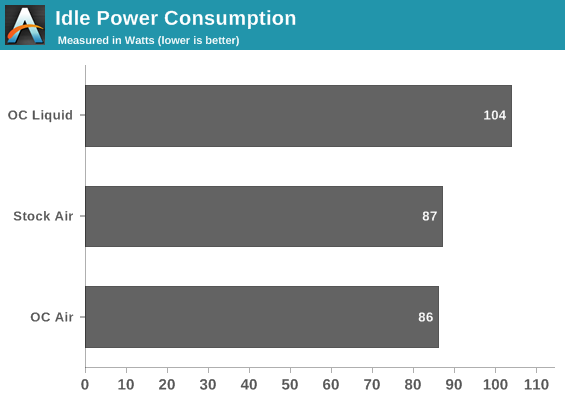

Given the way idle voltages are handled by Haswell and Kepler, it's reasonable to suggest the liquid cooling system adds about 15-20W of overhead as opposed to air cooling. Subtract 20W for the loop, and you're looking at our modest overclock tacking another 30W of power consumption on over the air cooling system. I'm at least a little nervous about what will happen when I flash the BIOSes of the GTX 780s to unlock a small voltage boost down the road.










106 Comments
View All Comments
Sadrak85 - Monday, September 30, 2013 - link
And one more thing is the addition of onboard voltage regulation, which is a lossy process almost by definition. Meaning, even with the better TIM, I seriously have my doubts that the thermals could hit the level of IVB or SB. Unless Intel somehow has some magic way of using the voltage and amperage they're scrubbing off.*small note, a good motherboard input, in terms of electricity, would pass through the filters pretty cleanly, but because Intel sets the specifications for the input, I have my doubts that they require such a thing, since the feature they added to their chip was to save money for the motherboard vendor.
leafonwind - Monday, September 30, 2013 - link
The thermal interface material is minor compared to the interface distance. Thermal resistance is L/kA. Going from a millimeter of thermal paste to an 10 micron gap (typical of paste when applied correctly) will give a 50x improvement. The difference in k between a good thermal paste and a bad thermal paste is typically a 5x difference unless you get into exotic materials like cadmium. http://forums.anandtech.com/showthread.php?t=22618...gandergray - Tuesday, October 1, 2013 - link
To bolster Von's point, see the work performed by Idontcare: http://forums.anandtech.com/showpost.php?p=3405318... .merikafyeah - Monday, September 30, 2013 - link
Super tiny correction: While it is true that liquids draw away heat much better than air, one must be cautious not to mistake water as a good CONDUCTOR of heat, aka something that "transfers" heat very well. Water is in fact an INSULATOR of heat, aka something that "absorbs" heat very well.merikafyeah - Monday, September 30, 2013 - link
Note wording on first page, third paragraph.ShieTar - Monday, September 30, 2013 - link
Correct, but to be precise, neither air nor water will conduct heat quickly enough for PC cooling purposes, both are only used to absorb the heat before being transported away from the heat source.Which makes you wonder how a closed-loop, compressed air cooling system would fare against a water-cooling system. Heat capacity might still be lower for air than for water, even at increased pressures, but I assume that you can produce higher flow rates for a compressed gas than for a liquid. And you could use the required compressor in order to:
1) Reduce the air temperature below room temperature before sending it to the heat sources.
2) Increase radiator temperature over the CPU/GPU temperatures, thus achieving the same heat transfer with lower air flow rates through the radiator. Though temperatures above 100°C may be unsafe in a consumer device for several reasons.
Does anybody know if such a system has been considered and tested anywhere?
Death666Angel - Monday, September 30, 2013 - link
Considered? Probably. Used? Not to my knowledge. If you have a compressor it makes more sense to cool the water used in the loop to just above freezing or even below freezing with the right additives. Of course, if you cool it that much, you have to worry about condensation, so most people I read about who use compressor cooling for their liquid (instead of large radiators) keep the water around room temperature and have the cooler in another room, to not be bothered by the noise.The stuff that is used to conduct heat away from the components inside the PC is the metal heatsink. In the case of pure air cooling you then push air through the metal heatsink fins. Because of the delta T you have the air warming up, the metal cooling and being able to absorb heat from the CPU/GPU etc. again. In case of water cooling, you have the water running through the heatsink (usually some very fine canals inside that increase surface and flow rate) which absorbs the heat from the heatsink and gets transported to (large) radiators where air is again pushed/pulled through the radiator fins in order to cool it.
Sadrak85 - Monday, September 30, 2013 - link
Used all the time; Nitrogen is the most common component of air; it is compressed so much as to become a liquid. Then, thanks to the Carnot cycle, cooling the liquid to room temperature results in it boiling and becoming ultra-cold air, which cools a processor.A similar thing happens with your refrigerator.
These coolers, however, require massive power to get them to that level, so they're only really useful for very niche-applications, but the equipment isn't really that hard to find. An evaporator will cost you something like $200 to $300, and then the Nitrogen.
Now, if you're talking about keeping the air gaseous, then what you'll find is it just isn't possible. Cooling it very much with pressure on it will result in it condensing to liquid. If you just compress it, without the cooling, you'll heat it up, of course, which is how your diesel engine works.
ShieTar - Monday, September 30, 2013 - link
Fair enough. I am fully aware of the cooling concept via liquid nitrogen boiling itself, but I was considering a much simpler concept. Maybe I should describe it in a bit more detail.Imagine a closed air (or just nitrogen) system where the air pressure is about 3 bar within a radiator and about 2 bar when it circulates within the cooling blocks. You can have temperatures around 200K at 2 bar without liquifying, and not that much higher at 3 bar.
So you offer your GPU/CPU coolers 2bars of air at 200K, maybe heat it to 220K, compress it to 3bar/330K, cool it back down to 300K (close to room temperature), decompress back to 2bar/200K.
What needs a little more math is, just how much volume of gas do I need for this to transport 600W or so of power by this concept. And how much additional energy do I waste on the compression process. And probably, just how horribly noisy will this setup get with 2bars of air at high velocities getting pressed through the cooling blocks at high velocities.
Yeah, the more I think about it, the worse the whole concept sounds. Nevermind it.
UltraWide - Monday, September 30, 2013 - link
Excellent article, I enjoyed reading this journey into water cooling. Keep up the great work!